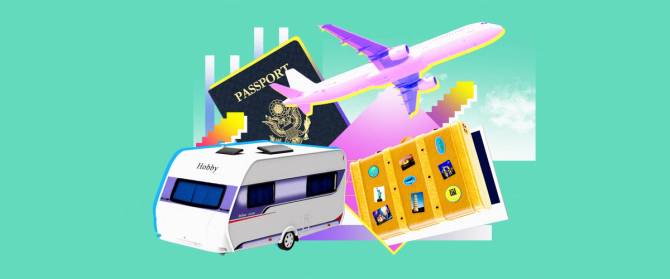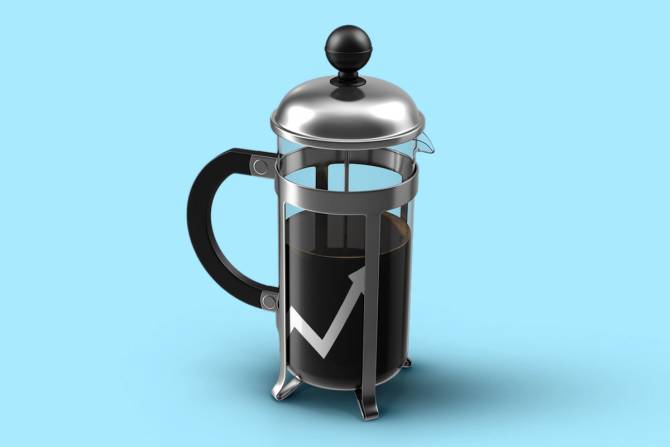Happy Friday. Even though we’re still in the middle of summer, don’t be surprised if you’re already seeing back-to-school ads. You know what that means: The pumpkin-spice latte discourse isn’t far behind. 
In today’s edition:
—Ryan Barwick, Alyssa Meyers, Patrick Kulp
|
|
Morning Brew
Behind almost every vacation is an advertising agency.
Okay, maybe not. But they don’t hurt—even the world’s biggest cities and nicest beaches rely on marketing from time to time. Development Counsellors International (DCI) is an agency that almost exclusively markets *jazz hands* destinations, working with destination marketing organizations (DMOs) to get people to visit for recreation, relocation, or business.
Its past clients include tourism orgs representing places ranging from Arizona and Abu Dhabi to Baton Rouge and Berlin to Seattle and Scotland. You get the idea.
The type of work it does varies. Last year, it worked with Belize’s tourism board “to position the destination as the best choice for travelers considering Latin America.” A different campaign focused on highlighting Scotland as a place ripe for business meetings and conferences.
Presumably, it’s all a bit different than advertising shampoo, so we chatted with Sumiti Gupta, director of media performance and SEM at DCI, about what goes into tourism marketing.
On what a DMO is: “Basically, a DMO takes a destination’s marketing efforts into their hands…For Belize, for example, they’re a client. People who are in Canada, we let them know that there is this destination that has private beaches, is a World Heritage Site, has outdoor adventures. We tell them that this destination exists.”
On DMO budgets today and how they compare to pre-pandemic: “It depends from destination to destination. For Belize, their budget has been progressively increasing. It hasn’t reached pre-pandemic levels because they’re still building and recovering their economy, but it has been progressive after the pandemic. In 2021, the budget was very low, but in 2022, it increased and almost doubled, and now it’s increasing more every year as they are seeing the results of our marketing efforts.”
Read more from our conversation with Gupta here.—RB
|
|
Did you know there are almost 50 million influencers in the world? With so many different voices—with audiences ranging from millions to niche communities of just a few thousand people—brands and influencers can build extremely powerful relationships.
If you’re a marketer interested in running a social influencer campaign, check out this resource to learn the ins and outs of collaborating with creators and social influencers. Find out how to better connect with your target audiences and ensure the mutually beneficial success of your partnership.
Download your copy here.
|
|
Illustration: Francis Scialabba, Photos: Poolsuite, Vacation
This week, we’re highlighting some of our favorite summer-themed stories that Marketing Brew has written in the past. Last summer, we wrote about Poolsuite, an internet radio station that started in 2014, has served as a marketing tool of sorts for sunscreen brand Vacation.
What do an ’80s-themed sunscreen brand and an NFT have in common? Both ideas started with an internet radio station.
No, this isn’t a Mad Lib. It’s the story of Poolsuite, an “internet leisure corporation” that began as Poolside FM, the aforementioned radio station playing channels of retro summer songs meant to conjure the vibes of “ridiculous ’80s beach movies,” said founder Marty Bell, who came up with the idea for the site in 2014 on a rainy day in the Highlands of Scotland.
“It had tons of traction since day one,” Bell told Marketing Brew. “[It] blew up on Twitter. I had no followers, no internet following at all. But Poolside FM blew up just because it felt nostalgic and happy and infectious.”
The site was a passion project for Bell, who at the time had recently co-founded a DTC sunglasses brand called Tens, and went on to co-found fintech company Nude. In the years since Poolside FM went live, Bell has heard pitches to tie the site to products from beer to swimwear to pool floats. They all felt “very obvious and not particularly exciting to me,” he said.
Then Bell met Lach Hall and Dakota Green. The pair were working on an ’80s-inspired line of sunscreen, partially motivated by the music and community of Poolside FM, now known as Poolsuite due to a trademarking issue, according to Bell.
He said he’d “been down the rabbit hole of ’80s sunscreen brands” many times before he met Hall and Green. “All those same brands still exist, but they’re these very sad versions of their former selves,” Bell told us.
The potential to experiment with elements like smell and packaging in “a pretty boring space” was intriguing to Bell, so the three started the Vacation sunscreen brand in April 2021 as an extension of Poolsuite.
Keep reading to find out how Poolsuite and Vacation have promoted each other’s brand growth.—AM
|
|
Demaerre/Getty Images
Despite what hundreds of Twitter threads and LinkedIn posts might tell you, nobody knows for sure how the new wave of language-generating AI could change the economy or the job market.
A recent report from McKinsey made some educated guesses based on the firm’s own data. The consultancy analyzed 63 use cases for the technology and ultimately estimated the tech could add $2.6 trillion to $4.4 trillion to the global economy. (These types of figures should of course be taken with a grain of salt; research reports predicted a multitrillion-dollar metaverse market before tech and media giants began divesting from the space.)
Here are some of the ways that McKinsey’s report predicts generative AI might transform the economy and workplace.
Workplace automation: The report estimates that generative AI, in addition to existing types of machine learning and other technologies, could automate tasks that take up between 60% to 70% of a typical worker’s day. Because of its increasing ability to handle language-related tasks, the report’s authors suggest that the tech will have a greater impact on “more-educated workers” compared to previous waves of automation.
Customer service is key: The report found that about three-quarters of generative AI’s value will be concentrated in customer operations, marketing and sales, software engineering, and R&D. That means uses like helping customer service reps address problems, generating creative material for advertisements, and turning natural language commands into computer code. The report’s authors wrote that the ability to instantaneously produce personalized answers to complex customer questions with a consistent brand voice marks one way AI could “transform” customer service.
Read the full story from Tech Brew here.—PK
|
|
Francis Scialabba
There are a lot of bad marketing tips out there. These aren’t those.
Track it: LinkedIn offered tips on measuring performance when it comes to B2B branding.
Write it down: Check out three ways to help improve your case studies.
Testing, 1-2-3: The case for ditching creative testing in favor of other ways to create effective ads.
Connection starts here: Is your relationship marketing strategy falling flat? Get Marigold’s ebook and be inspired by real brands’ approaches to interacting with their customers—from initial impressions to final conversions. Get your copy.* *This is sponsored advertising content.
|
|
|
Written by
Ryan Barwick, Alyssa Meyers, and Patrick Kulp
Was this email forwarded to you? Sign up
here.
Take The Brew to work
Get smarter in just 5 minutes
Business education without the BS
Interested in podcasts?
|
ADVERTISE
//
CAREERS
//
SHOP 10% OFF
//
FAQ
Update your email preferences or unsubscribe
here.
Please Note: We've recently updated our Privacy Policy. View our privacy policy
here.
Copyright ©
2023
Morning Brew. All rights reserved.
22 W 19th St, 4th Floor, New York, NY 10011
|
|







